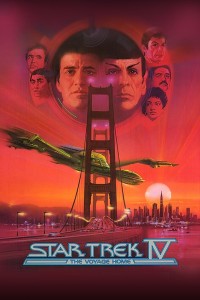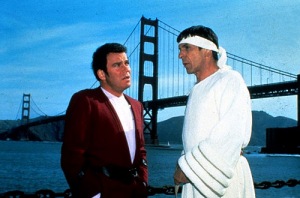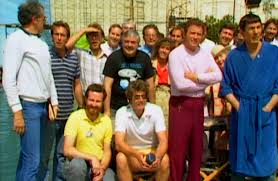Leonard Nimoy’s “Voyage Home”
SPOCK THE DIRECTOR ON SET OF AMAZINGLY PRESCIENT “STAR TREK IV”
By Glenn Lovell
SAN FRANCISCO ‒ As every Trekker worth his weight in Klingon plunder knows, San Francisco ‒ in the 23rd century ‒ is Starfleet Headquarters.
There was a glimpse of that futuristic metropolis in 1979’s “Star Trek: The Motion Picture” and again three years later for the opening scenes of “Star Trek II: The Wrath of Khan,” when Admiral James T. Kirk went through another of his mid-life crises and had to be cajoled back to active duty by Dr. Leonard “Bones” McCoy.
But the Starfleet Headquarters in those installments were optical illusions ‒ process shots done at Paramount and George Lucas’ Industrial Light & Magic (ILM) in San Rafael.
For “Star Trek IV: The Voyage Home,” which takes place in the past (our present), Paramount and director-star Leo nard Nimoy wanted real Bay Area locales. “IV,” due out this winter, has now moved on to post-production in Los Angeles and ILM. But the “Star Trek” company was in San Francisco recently, and shot sequences at the Monterey Bay Aquarium and in Sausalito as well.
nard Nimoy wanted real Bay Area locales. “IV,” due out this winter, has now moved on to post-production in Los Angeles and ILM. But the “Star Trek” company was in San Francisco recently, and shot sequences at the Monterey Bay Aquarium and in Sausalito as well.
☐
IT’S the last day of the shoot, and Nimoy/Mr. Spock has put aside his Vulcan ears and is concentrating on directing William Shatner and Catherine Hicks. They’re sitting at a table in a mock-up of a North Beach Italian restaurant, amusing themselves between takes by fencing with bread sticks. The art-deco eatery is actually located on Soundstage 2 of the San Francisco Studios, which is at the 7th Street exit off Highway 101.
Everyone on the set seems relaxed and in good spirits. Probably because all that’s left to shoot is the tête-á-tête over pizza, and then the special effects, which will be minimal because the new story finds Admiral Kirk (William Shatner) and the gang returning to “the Earth’s past in an effort to preserve the Earth’s future.”
Plot points on the $23-million adventure are being kept like state secrets. And, all who visit are told “Shatner absolutely refuses to do any interviews.” This jibes with the how-dare-you glower received when a reporter introduced himself to Shatner on the street. Sporting a regulation-maroon Starfleet uniform, toupee and a layer of tanning makeup, the star curtly excused himself and, dodging the autograph-seekers on the corner, disappeared into his trailer to study the day’s lines.
Now, sitting across from Hicks, Shatner seems bored, aloof. He’s not even attempting to hide his considerable paunch.
”Quiet on the set,” the assistant director orders.
A soft, reassuring voice from somewhere behind the camera says, “OK, action.” Forty-plus extras begin making like patrons at a popular restaurant. This isn’t hard because the set has been catered by Vanessi’s in North Beach. The pasta and Chianti definitely aren’t special effects.
The scene calls for Hicks (best known for TV’s “Marilyn: The Untold Story”), a marine biologist with the Sausalito Aquarium , to order dinner. Shatner responds with a line about the Earth’s whale population. This is the key to “Star Trek IV,” which comes with a strong conservationist message.
 “Do you trust me?” Hicks’ scientist asks
“Do you trust me?” Hicks’ scientist asks
“Implicitly,” Shatner’s Kirk responds with typical devil- may-care smirk.
“I’ll have a large mushroom (pizza), with pepperoni and extra onions,” Hicks tells the waiter.
A moment of silence. Space jockeys from the future obviously don’t know from pizza pies.
“And you, sir?” the waiter asks.
“Make that two,” Shatner shrugs, all the while staring into Hicks’ sparkling baby blues.
“Excellent. Perfect. That’s a good one,” director Nimoy tells cinematographer Don Peterman (who also shot “Flashdance” and “Cocoon”).
Nimoy and company kibitz as the crew repositions the camera for reverse angles of Shatner. The next exchange holds more clues to the new plot, said to be enthusiastically endorsed by series creator Gene Roddenberry, who again serves as executive consultant.
“I can take those whales somewhere ‒ where they wouldn’t be hunted,” Shatner tells the doctor.
“You can’t even find your way from Sausalito to San Francisco,”
Hicks points out.
☐
And so it goes for the rest of the afternoon. Swashbuckling, it ain’t.
But that’s the point, everyone here says “Voyage Home,” in sharp contrast to the first “Star Trek” movie, will stress humor and romance and character development, not warp- speed dogfights.
The new installment, Nimoy emphasizes between takes, is “a kind of romantic homecoming for us in a couple of ways. We’re finally in San Francisco, and we’re back dealing with the human elements so important to the success of the TV series. There’s a sense of coming full circle with this one.”
☐
“Voyage Home,” various sources report, picks up where “Star Trek III: The Search for Spock” left off ‒ on the planet Vulcan, where Spock, “dead” since the closing scenes of “Star Trek II,” has his “katra” (life’s essence) restored by High Priestess T’Lar (Dame Judith Anderson).
 Back in one piece but still obviously out of it, Spock submits to three months of “re-education” and then joins the Trek regulars (DeForest Kelley as Bones, George Takei as Sulu, Walter Koenig as Chekov, James Doohan as Scotty) as they journey back to fleet headquarters in a commandeered Klingon ship. (Remember, the Starship Enterprise was destroyed in “III.” Kirk, distraught over the murder of his son on the planet Genesis, rigged the Enterprise to self- destruct, then beamed aboard his Klingon captors.)
Back in one piece but still obviously out of it, Spock submits to three months of “re-education” and then joins the Trek regulars (DeForest Kelley as Bones, George Takei as Sulu, Walter Koenig as Chekov, James Doohan as Scotty) as they journey back to fleet headquarters in a commandeered Klingon ship. (Remember, the Starship Enterprise was destroyed in “III.” Kirk, distraught over the murder of his son on the planet Genesis, rigged the Enterprise to self- destruct, then beamed aboard his Klingon captors.)
At the start of “IV,” Kirk and company are on their way home to “face what could be very serious charges” for disobeying orders. It is while in transit that Spock’s Vulcan ears detect a strange signal, warning of an immense object headed toward Earth. Said object will eventually cause a great cloud cover to block out the sun and threaten all life forms on the planet. Spock eventually cracks the coded message: It’s a whale’s song.
But whales have been extinct for centuries, the victims of 20th century greed and carelessness . . .
So, as they did in the celebrated “City on the Edge of Forever” episode of the TV series, Kirk and crew beam themselves back in time ‒ on a mission to save Earth from itself. The unfolding drama, we’re assured, will combine suspense, romance and lots of culture-clash comedy.
Spock also must comes to terms with his human mother, Amanda, who is played by veteran actress Jane Wyatt “in a brief but important scene.” Wyatt originated this role in the 1967 TV episode “Journey to Babel.”
The brass at Paramount is banking on another “Star Trek” bonanza. The first installment grossed a record $17 million its first week in release. Final take: $90 million. “The Wrath of Khan” picked up a tidy $31 million its first 10 days in release, making it the single highest grosser for that period in Paramount’s history. Final gross: $80 million. If adjustments are made for inflation, “The Search for Spock,” which marked the movie directorial debut of Nimoy, was, likewise, a major draw, earning $77 million in ticket sales.
So a lot is riding on this “Voyage Home.” Will it be heart-tugging and extravagant enough to appeal to Trekkers and non-Trekkers?
“I hope this picture will be accessible to somebody who doesn’t know anything about ‘Star Trek,’ ” Nimoy says, “but there are references to the other pictures ‒ there are moments when they’ll feel a little bit out of it.”
☐
Between takes, Nimoy ‒ sans Vulcan ears ‒ talks about the “Star Trek” legacy, his excitement over the latest installment and the long road to acceptance as a bankable filmmaker who also occasionally dabbles in theater (“Six Rms Rv Vu,” “Vincent”) and airline commercials.
This afternoon Nimoy looks more like an Ivy League literature professor, dressed as he is in sleeveless sweater and gray slacks. He refuses to do interviews in character. “He’s very particular about that,” whispers a member of the crew. “He never does interviews as Spock.”
Unlike others who have been eclipsed by their screen persona (Sean Connery’s James Bond comes to mind), Nimoy, 55, has used his popular typecasting as the inscrutable Spock to gain a foothold in other areas of the business. He agreed to “Star Trek II,” only if Paramount granted “other creative opportunities.” The Emmy-nominated role in “A Woman Called Golda” followed. So did the opportunity to direct “Search for Spock.”
Some have called this blackmail. Nimoy chooses to look upon it as a shrewd career move. Directing, he says, has always been his first love. Why not trade time in front of the camera for the pleasure of working behind the scenes?
“What people tend to forget is, I’ve been around a long time,” he continues. “I was working on a Hollywood soundstage in 1950. My first movies were ‘Queen for a Day’ and ‘Francis Goes to West Point.’ I even appeared in Republic’s last Saturday-matinee serial, Zombies of the Stratosphere.’
“Directing for me is unfinished business. I started out wanting to direct, as far back as 1960, when I was enrolled in a director’s training program at MGM. But then we did the ‘Star Trek’ TV pilot and the series sold, and my career as a director was sidetracked by my success as an actor.”
Nimoy’s TV credits as director include episodes of “T.J. Hooker,” “The Powers of Matthew Starr” and “Rod Serling’s Night Gallery,” a show on which fellow directors Steven Spielberg and Jeannot Szwarc (“Supergirl”) also apprenticed. “But this picture is my biggest challenge. It’s the most physical ‘Star Trek’ in terms of size and scope. It’s major motion picture time, folks! But there’s almost more texture to this one, a greater range of emotion and humor . . . And we’re dealing with an important, timely issue.”
The ecology aspects of the new “Star Trek” came to Nimoy as he read a chilling study by Edward O. Wilson called “Biophilia” (Harvard University Press, 1984). It predicts that, if the current rate of pollution continues, the Earth stands to lose 10,000 species a year by 1990. Nimoy sought corroboration from scientists at Harvard, the Massachusetts Institute of Technology and the University of California at Santa Cruz, where he conferred with the school’s dean of natural sciences, Frank Drake.
The research was passed on to Nicholas Meyer and producer Harve Bennett, who will share screenwriter credit with Nimoy. The completed script was hand delivered to Roddenberry for the final OK. Roddenberry, according to Nimoy, said, “It looks so good it scares me.”
“Gene always meant for ‘Star Trek’ to be more than another science fiction series,” says Nimoy. “He meant for it to be a comment on the human condition ‒ a way of looking at the 20th Century from the perspective of the 23rd. I think the new ‘Star Trek’ does this better than any of the others.”
Nimoy describes the first ‘Star Trek’ movie, directed by Robert Wise, as “frustrating ‒ a carefully crafted piece of work that focused on everything but the characters.” The next two movies, in his estimation, “returned the family of characters . . . So we’ve continued to improve with each one.”
Even with the save-the-whales plea, “Voyage Home” is a lot lighter in tone than the others, Nimoy wants it known. “It’s a lot more of a romp, like ‘Raiders of the Lost Ark.’ We zigzag a lot with this one. And Spock is on screen a helluva lot more. He’s alive, but there’s a question of his mental capacity. You’ll see Spock evolve into a three-dimensional character this time.”
Published June 15, 1986

Leave a comment